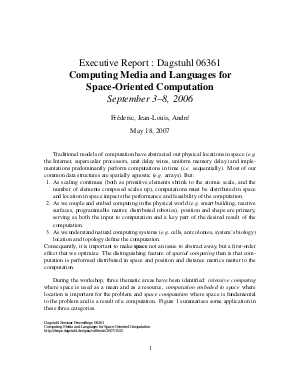06361 Executive Report – Computing Media Languages for Space-Oriented Computation
Authors André DeHon, Jean-Louis Giavitto, Fréderic Gruau
-
Part of:
Volume:
Dagstuhl Seminar Proceedings, Volume 6361
Part of: Series: Dagstuhl Seminar Proceedings (DagSemProc) - License:
 Creative Commons Attribution 4.0 International license
Creative Commons Attribution 4.0 International license
- Publication Date: 2007-05-31
File

PDF
DagSemProc.06361.2.pdf
- Filesize: 91 kB
- 5 pages
Document Identifiers
Subject Classification
Keywords
- Hardware architecture
- computing medium
- space-oriented computation
- nonconventional programming models
Metrics
- Access Statistics
-
Total Accesses (updated on a weekly basis)
0PDF Downloads0Metadata Views
Abstract
With the cheap availability of high capacity spatial computing substrates, an emerging understanding of natural systems, and the possibility of computationally engineered matter, the importance of spatial aspects of computation is growing. These different manifestations of spatial computing have clear intersections where they can share common theory, tools, and insights. A solid mastery of spatial computation will allow us to transform our engineering capabilities, our understanding of the natural world, and ultimately the world in which we live.
Cite As Get BibTex
André DeHon, Jean-Louis Giavitto, and Fréderic Gruau. 06361 Executive Report – Computing Media Languages for Space-Oriented Computation. In Computing Media and Languages for Space-Oriented Computation. Dagstuhl Seminar Proceedings, Volume 6361, pp. 1-5, Schloss Dagstuhl – Leibniz-Zentrum für Informatik (2007)
https://doi.org/10.4230/DagSemProc.06361.2
BibTex
@InProceedings{dehon_et_al:DagSemProc.06361.2,
author = {DeHon, Andr\'{e} and Giavitto, Jean-Louis and Gruau, Fr\'{e}deric},
title = {{06361 Executive Report – Computing Media Languages for Space-Oriented Computation}},
booktitle = {Computing Media and Languages for Space-Oriented Computation},
pages = {1--5},
series = {Dagstuhl Seminar Proceedings (DagSemProc)},
ISSN = {1862-4405},
year = {2007},
volume = {6361},
editor = {Andr\'{e} DeHon and Jean-Louis Giavitto and Fr\'{e}dric Gruau},
publisher = {Schloss Dagstuhl -- Leibniz-Zentrum f{\"u}r Informatik},
address = {Dagstuhl, Germany},
URL = {https://drops.dagstuhl.de/entities/document/10.4230/DagSemProc.06361.2},
URN = {urn:nbn:de:0030-drops-10252},
doi = {10.4230/DagSemProc.06361.2},
annote = {Keywords: Hardware architecture, computing medium, space-oriented computation, nonconventional programming models}
}
